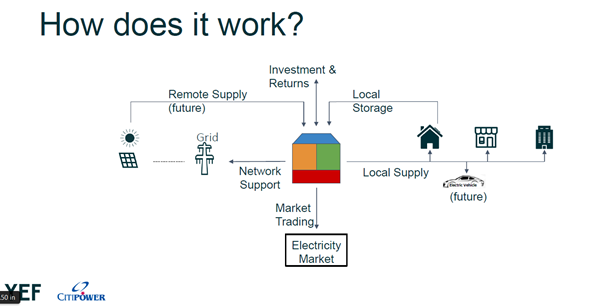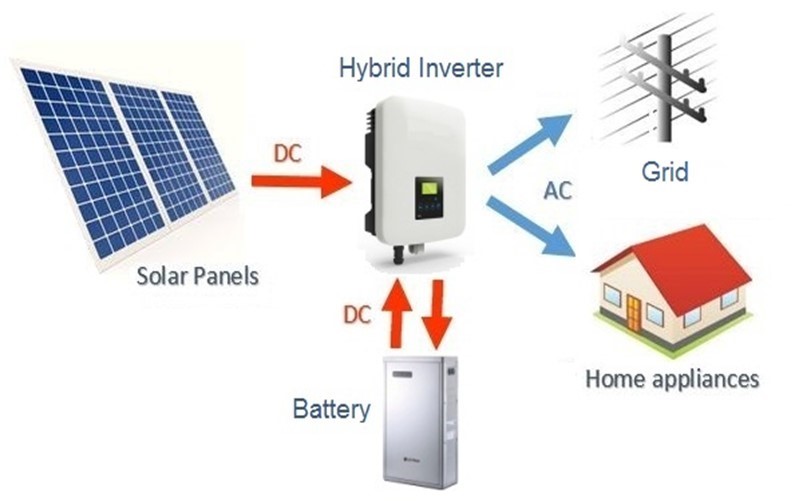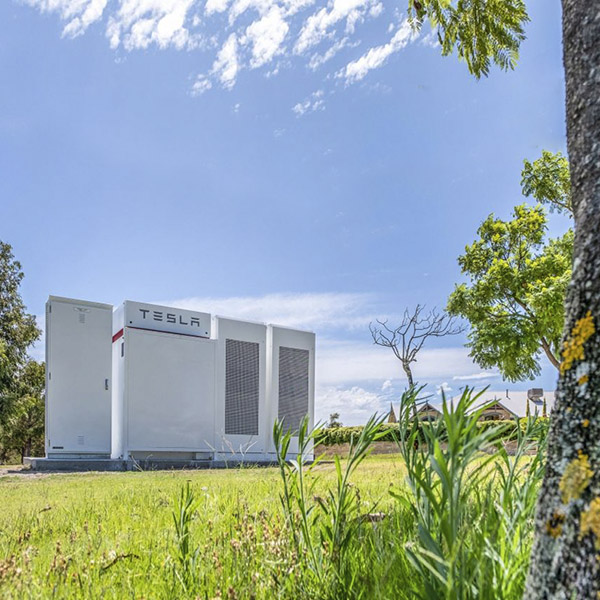What is a community battery?
Community batteries can be scattered around cities and shared between households in a particular neighbourhood or street. They allow households that generate their own solar power to pool their excess electricity in shared storage for later use. The picture above is of one of Western Power’s community batteries in a trial at Ellenbrook, a Perth suburb.
Community batteries deliver benefits to the entire community, whether residents have solar panels or not. This is because they are placed in areas where the network needs upgrading or adjusting to maintain power reliability and quality. For example, for an older part of the network, there might be too much pressure on a transformer to accept the projected two-way flow of power. They are a middle level of storage, between the ever increasing network-scale big batteries, and behind-the-meter home batteries (and in the future aggregated EV batteries in vehicle-to-grid (V2G)).
Community batteries soak up any excess solar power and smooth the flow, improving power reliability and quality to customers. The alternative is to reinforce the network and to push the problem further up the chain which is more expensive and results in additional costs for all customers. Community batteries are a win-win for customers and the grid.
How will community batteries work?
Community batteries will provide services to multiple parties. The diagram below shows how a community battery might be located:

In this diagram the battery is:
- Providing network support services;
- Providing local storage and supply to local customers;
- Trading in the electricity market.
The diagram also shows that the battery could support remote supplies in the future.
It is likely that a community battery in Victoria will be owned by a third party that can provide network services, can provide storage and supply services to local customers and can support energy trading.
The provision of network services
A community battery can control the flow of electricity across the network (primarily solar feed-in) and can provide voltage regulation services. In addition, a community battery can reduce the high cost of upgrading existing power infrastructure, in areas that have high energy demand during peak demand hours, The network owner will pay the community battery owner for the provision of these services.
The provision of local storage and supply to local customers
The community battery can be shared by eligible customers who generate solar energy through panels on their rooftops. As the solar panels generate power during the day, customers can automatically store some of their excess or unused power in the battery. Each customer will pay for the services provided by the community battery. The level of fees will depend on the capacity purchased.
The community battery will be owned and maintained meaning that customers will not have to outlay the costs of purchasing a behind-the-meter battery or deal with battery degradation issues. Customers can also get the right size battery for their needs and, as it’s virtual, don’t need to find extra space in the garage to set the battery up.
Supporting trading in the market
The community battery owner can trade in the market or can provide support to an energy trader. In either case, the battery owner can earn revenue from energy trading.
Yarra Energy Foundation
The Yarra Energy Foundation (YEF) is a not-for-profit organisation providing services and advice to homes and businesses that want better energy. The YEF provides a range of services helping the community reduce costs and reduce emissions. The YEF has signed a new agreement to unlock the potential of community-scale battery storage in the Melbourne CBD and inner-city suburbs with Victorian electricity distributor, CitiPower. More details from YEF and CitiPower are available here.
Chris Wallin, Community Battery Project Direector at Yarra Energy Foundation and Greg Hannan, Head of Network Solutions at CitiPower/United Energy spoke at a Lighter Footprints Community Battery event on 30 June. You can check the You Tube video (with chapter points) for a great summary of the benefits (and some challenges) of community benefits to the householder, the network and the community.
- Thanks to YEF for the video highlights edit
- Copies of the presenters’ slides can be here, and images of the event here.
- Check out the YEF post on our event.
- Find out more on our Community Battery page where you can sign up for quarterly updates.
Community batteries, home batteries and VPNs – a comparison
Community batteries
Community batteries operate in front of the meter and provide services in specific network areas. They can provide network services as well as acting as batteries for a number of customers. Community batteries are larger batteries than home batteries and are better value for money on a storage per dollar basis. However, being placed in front of the meter creates a number of issues that home batteries do not face.
Examples of the additional complexity include:
- Customers using the battery are using the distribution network to pass power to and from the community battery. New distribution tariffs may be necessary.
- The connections between the network and the customers are complex and require smart management systems;
- It will be necessary to work with a retailer to develop commercial retail tariffs that support the customers using the community battery.
Home batteries
Home batteries are installed behind the meter. Flows between the solar panels, the battery and the house do not cross the network and are not subject to network tariffs or retail tariffs (see illustration below).

Configuration of home with solar and battery
However, home batteries are relatively expensive solutions and it is expected that community batteries will have price advantages over community batteries.
Virtual power plants
Virtual power plants aggregate home batteries and can provide some of the additional benefits of a community battery. However, the cost of many home batteries is considerably greater than the cost of a community battery with a similar storage capacity. To date, most VPPs have concentrated on market trading.
Comparison summary
At this stage, it looks as if community batteries will establish an ongoing role in distribution networks. In addition community members who lease battery capacity from a Community battery will receive that capacity for the term of their contract. The community battery owner will add capacity as necessary as the original battery degrades. The purchaser of a home battery, for example, will find that the capacity has reduced to approximately 80% of the original capacity within a few years.
The current status of community batteries
Community batteries have been installed in several states. Some of these batteries are in remote communities and some provide network support only. However, there are now a few community batteries being trialled that allow customers to save surplus energy and draw down on that energy. The Mckell Institute has produced a report titled “Power to the People: Proposals to Increase the Rollout of Community Batteries” that provides information on these installations.
It should be noted that the regulatory regime in Western Australia is different from the regulatory framework covering the NEM and, as a result, solutions in Victoria may differ from those in Western Australia.
Determining where to place a community battery
Western Power has detailed how they determine where a community battery is required. Not surprisingly, areas with large dollar uptake are key candidates. However, the age of the network is also a deciding factor. Newer parts of the network will be able to handle higher traffic than older parts. Details of how Western Power determines the location for a community battery are detailed on their website.
Inequities
Incentives to install solar
The Victorian State Government and the Federal Government have put in place incentives for customers who install solar. These subsidies take the form of premium feed-in tariffs and purchase subsidies. These subsidies primarily benefit those who own their own houses and who can afford to install solar. The subsidies are paid for by the population at large, including those who rent and those who cannot afford the up-front cost.
There is an argument that transitioning to renewable energy is a necessary step and it is appropriate for government to subsidise home solar. The level of subsidies available is falling as solar becomes cheaper and subsidies will probably become a thing of the past in a few years’ time. In addition, governments are looking to provide subsidised solar to broader sections of the community including rolling out solar to residents of subsidised housing.
Inequities in network charging
The large number of people installing solar is stressing the network and this is driving network providers to have to invest in upgrades. While the solar installations reduce demand, the introduced volatility and levels of feed-in can be substantial. Network expenditure may be required to handle the high levels of feed-in as well as controlling network voltage.
However, the network costs are recovered via a combination of fixed charges and per kWh charges on peoples bills (based on kWh delivered to the premises). This means that customers with solar will receive reduced network charges based on their reduced consumption (they consume less from the grid after they have consumed what they generate) even though this group of customers may be the ones making network upgrades necessary.
There are a number of ways that the inequity of the network might be reduced. Network owners are considering raising network charges on electricity exported to the grid and using that revenue to fund the strengthening of the grid.
It is also possible that community batteries may solve the problem. Community batteries can provide flatter load profiles in local areas of the grid. This will allow network businesses to handle greater levels of solar than they might otherwise have been able to. In addition, the lower loads from a local area will reduce network demand further up the network reducing the requirement for grid reinforcement.
To listen to Lighter Footprint’s Community Battery event You Tube video here.

